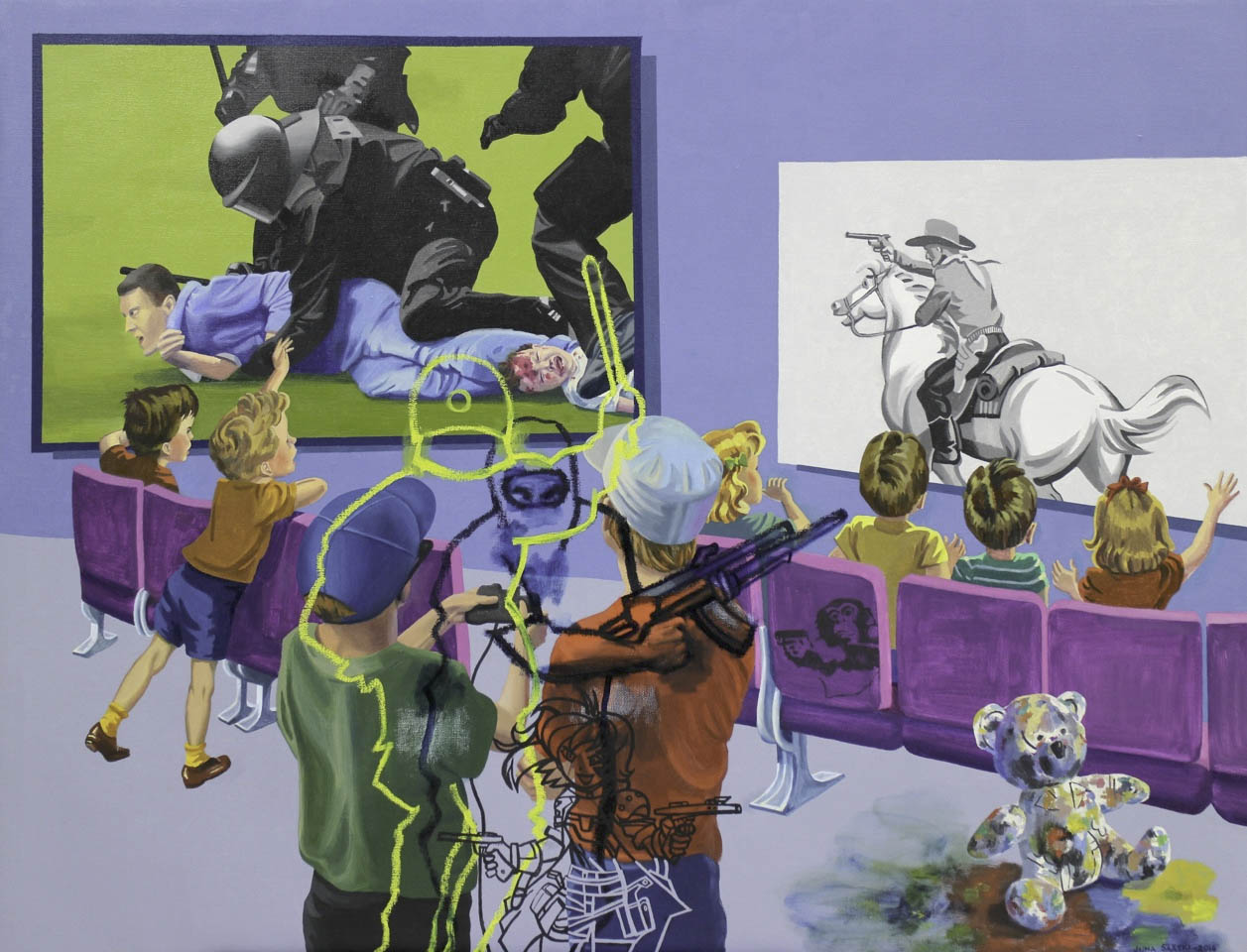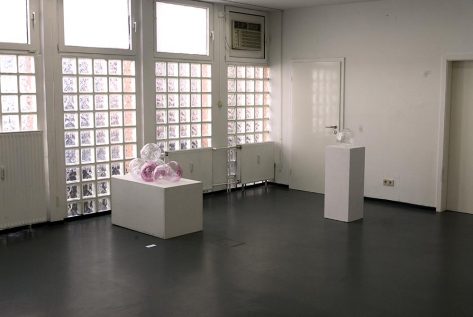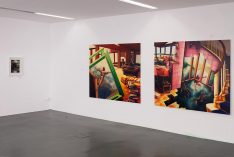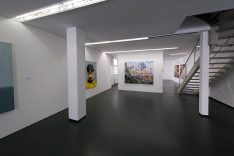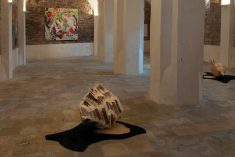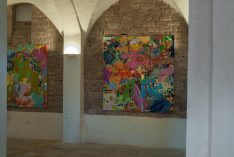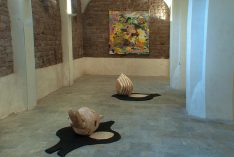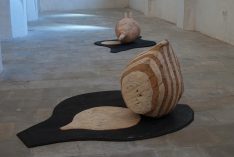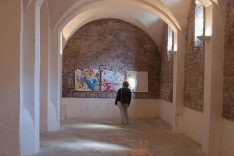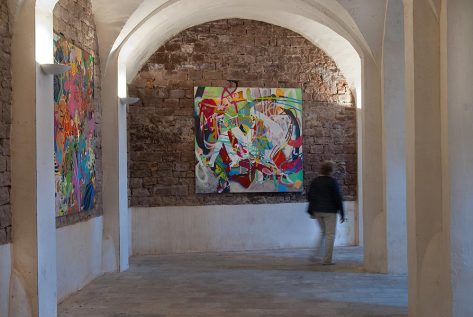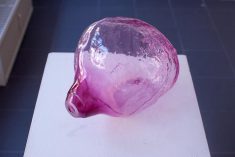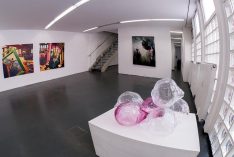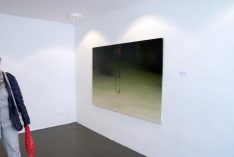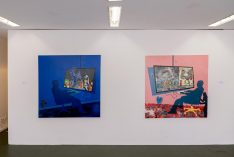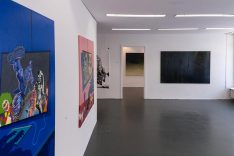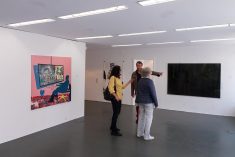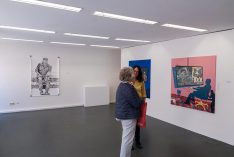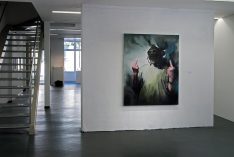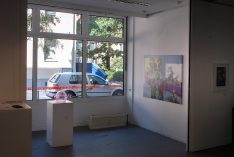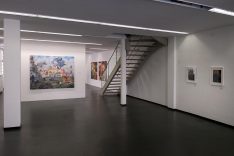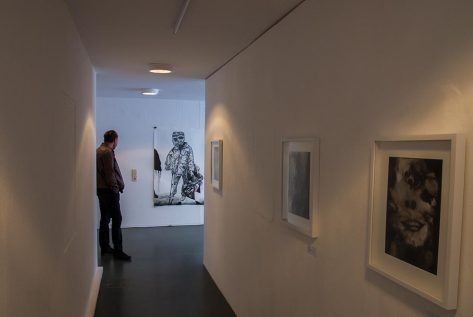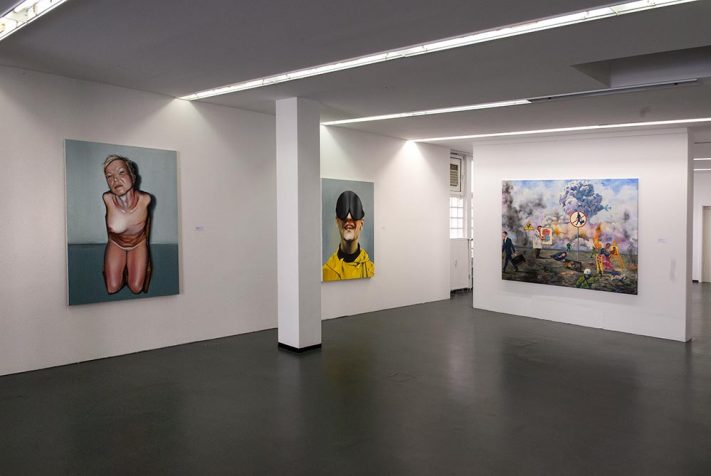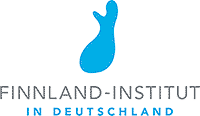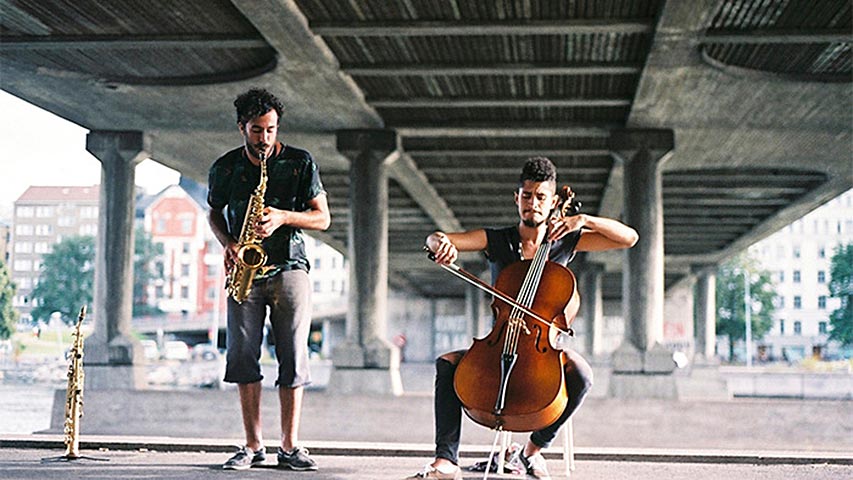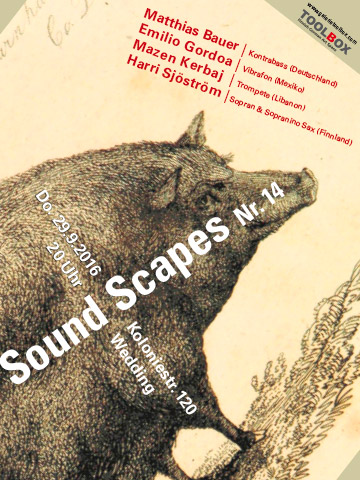Ausstellungsorte:
Toolbox exhibition in South Germany |
- Kunstverein Viernheim Hügelstraße 24, 68519 Viernheim
- Kunsthaus Viernheim Rathausstr. 36, 68519 Viernheim
- Strümpfe Mannheim Jungbuschstraße 3, 68159 Mannheim
Ein Kooperationsprojekt des Kunstvereins Viernheim mit Strümpfe Mannheim und Toolbox Berlin
Kunstverein Viernheim, Kunsthaus Viernheim
9. 9.–15. 10. 2016
Vernissage: 9. 9. 2016, 19 Uhr im Kunsthaus
Begrüßung: Dr. Laura Hirvi, Finnland-Institut Berlin
Öffnungszeiten
Do+Fr 15–18 Uhr und Sa 10–13 Uhr sowie nach Vereinbarung
2. 9.–23. 9. 2016
Strümpfe Mannheim
Vernissage: 2.+3.9. 2016 ab 20 Uhr
Öffnungszeiten nach Vereinbarung
Toolbox Artist Group Finland Berlin
Maija Helasvuo, Installation | Sampsa Indrén, Zeichnung
Minna Jatkola, Malerei | Mika Karhu, Video, Zeichnung
Niina Räty, Malerei | Juha Sääski, Malerei
Matti Vainio, Zeichnung | Andreas Wolf, Malerei
scroll down for English Version
Emotional Circus
von Anna E. Wilkens
Der Diskurs um die Emotionen ist nicht neu; im Zuge gesellschaftlicher Modernisierungsprozesse beginnt das Reden über Gefühle in der Aufklärung um 1750 mit der „Empfindsamkeit“. Gefühle blieben seither Thema besonders in ästhetischer Theorie und in der im 19. Jahrhundert neu entstehenden Psychologie. Einen bemerkenswerten Aufschwung jedoch nahm die Aufmerksamkeit für Gefühle seit der Jahrtausendwende – eine Reihe neuer Sonderforschungsbereiche wurde in den Kulturwissenschaften, in Psychologie und Neurowissenschaften eingerichtet und man spricht sogar schon von einem Emotional Turn – vielleicht vorbereitet seit der 68er Wende im Zuge von Ganzheitlichkeitsdiskursen; seither gibt es vielfältige Argumentationen wider die alte Dichotomie von Ratio (positiv bewertet) mit ihrem angeblichen Gegenteil, der Emotio (negativ bewertet). Die Vernunft galt als zivilisiert und der Kultur zugehörig, das Gefühl als irrational und „natürlich“.
Bedeutet nun das vermehrte (wissenschaftliche) Reden über Emotionen auch eine Zunahme von Gefühlen? Höchstwahrscheinlich nicht. Und ebenso wenig ist es ein Indiz für eine „Befreiung“ der Gefühle – dass Gefühlsäußerungen (außer im Privaten) etwa zunähmen oder salonfähig würden. Man kann sogar, Foucaults Argumentation in Sexualität und Wahrheit folgend, die These aufstellen, dass die Sichtbarmachung der Gefühle im Diskurs eher zur noch stärkeren Beherrschung von Gefühlen beiträgt, indem der Diskurs immer auch normativ ist. Ein Indiz für die Präsenz eines Diskurses kann die Anzahl der Publikationen zu einem Thema sein: Im Katalog der Deutschen Nationalbibliothek (zum Beispiel) findet man tatsächlich eine Reihe von neuen Titeln zum Thema „Emotion“; es sollte jedoch zu denken geben, dass ein sehr großer Teil davon gar nicht in Kulturwissenschaften, Psychologie oder Neurowissenschaften erschienen ist, sondern in der BWL: Marketing einerseits und Personalführung andererseits. Dass wir alle von der Werbung zum Konsum bewegt werden (sollen), wissen wir; und Emotionale Intelligenz gehört heute zur Ausstattung einer vollwertigen Arbeitskraft. Und die Ratgeberliteratur seit den 70er-Jahren etwa hilft uns nicht nur bei der „Selbstfindung“ und Entdeckung unserer eigenen Gefühle, sondern sie legt implizite Normen fest, nach denen wir beispielsweise immerzu glücklich sein sollen und in Beziehungen auf jeden Fall erfüllte Liebe finden. Etwas zu erkennen, es präzise und differenziert erfassen zu können, führt immer auch zu größerer Beherrschbarkeit, ermöglicht Kontrolle. Der Prozess der Zivilisation (Elias), in dem der Fremdzwang zum Selbstzwang wird, wird fortgeschrieben.
Wirklich neu am zeitgenössischen Emotionsdiskurs seit etwa 2000 ist, dass auch in wissenschaftlichen Forschungen nun davon ausgegangen wird, dass menschliches Leben stets ein Zusammenspiel zwischen Denken und Fühlen sei; das Fühlen informiert das Denken und das Denken beeinflusst das Fühlen. Und das gilt im Bereich des privaten, individuellen Gefühls und Denkens als auch in größeren gesellschaftlichen Zusammenhängen (öffentlich); Emotionen werden von gesellschaftlichen Strömungen geprägt, sie sind folglich mindestens partiell historisch und nicht überzeitlich (das bedeutet auch, dass es Emotions-Moden gibt), und umgekehrt bestimmen die Gefühle ihrerseits gesellschaftliche Entwicklungen mit. Das impliziert auch, dass ein Wandel stattgefunden hat in der Wahrnehmung von Emotionen, die nicht länger als nur passiv (Passion), also erlitten und als Reaktion auf Umweltreize angesehen werden, sondern ihrerseits – aktiv – ihre Umwelt bestimmen oder jedenfalls beeinflussen.
Der Bereich der Kunst nun gilt seit ihrer Autonomisierung als eine Art Freiraum, in dem Elemente menschlichen Lebens sowohl thematisiert als auch ausgelebt werden können, die sonst unsagbar sind, entweder, weil sie tabu, oder aber, weil sie (noch) nicht wissenschaftlich erfassbar sind.
Die Künstlerinnen und Künstler der TOOLBOX zeigen in Viernheim unterschiedliche künstlerische Positionen zum Thema Gefühle: Die Werke beschäftigen sich mit Gefühlen im Schaffensprozess; mit Gefühlen, die als potenziell zerstörerische Unterströmung nicht zuletzt von Machtverhältnissen und Politik hervorgerufen werden; mit dem Sinnlichen von Kunstwerken; und auch damit, wie Medien und Werbung mithilfe psychologischer Erkenntnisse bestimmte Emotionen in ihrem Publikum hervorrufen.
Emotional Circus
Anna E. Wilkens
Talk about emotions isn’t new; in modern age Europe the discourse on feeling has its origin in philosophical and literary ‘Sentimentalism’ during the Age of Enlightenment, around 1750. Since then, emotions have constantly been a popular topic, especially in aesthtic theory and psychology, as a new discipline of the 19th century, though there has been a remarkable increase in attention to emotions in early 21st century. A number of special research facilities focussing on the study of emotions, mainly in Cultural Studies, Psychology and Neuroscience, have been established since the turn of the century, and the term emotional turn has been coined. Maybe this new attention to emotions has its roots in the seventies with the shift towards more universal and holistic approaches to the interpretation of society.
Nowadays we find a lot of arguments to dissolve the classical dichotomy of reason (with a positive connotation) vs. emotion (negative). Reason was deemed civilised and an aspect of culture; emotion on the other hand was conceived as irrational and belonging to nature.
Now, does the broadening of (academic) discourse on emotions mean that we actually feel more? Or are emotional outbreaks in public more acceptable than before? Probably not.
Following Foucault’s reasoning in The History of Sexuality, we could argue that the increase in talk about emotions doesn’t indicate any kind of liberation of feeling, but, on the contrary, that greater attention to the discourse on emotions engenders an enforcement of control of emotions, in that any discourse is, among other things, always also normative and an instance of regulation or even domination.
As evidence for its importance in contemporary thought the number of publications on the topic can be taken: In the catalogue of the German National Library for example we find a myriad of titles about emotions; but it is quite sobering that very many of these books on ‘emotion’ aren’t published in Cultural Studies, Psychology or Neurosciences, but in Business Theory: Marketing and Personnel Management. It is a well known fact that we all are (supposed to be) manipulated by advertising, and today emotional intelligence is something every employee should bring to the workplace.
And self-help literature doesn’t only helps us ‘find ourselves’ and ‘discover our emotions’ but also installs a set of implicit norms, according to which we are supposed to be constantly happy, and in intimate relationships by all means be fulfilled through love.
Awareness and knowledge about something always facilitates greater manageability, increases control. The Process of Civilisation (Elias), the transformation of external constraints into self-constraintsort, continues.
The novelty in contemporary discourse on emotions is the consideration even in scientific and scholarly research that human life always is an interplay of thought and emotion; feeling informs thinking, and reason influences emotions – in private, individual thought and emotion as well as in broader societal contexts (public); emotions are shaped by publicly discussed ideas, which means that they are at least partially historical and therefore subject to modification (from this follows that there must be fashions of emotion), on the other hand, feelings are important in shaping political and social change.
All of this implies that there must have taken place a change in the perception of emotions, which nor longer are conceived as passive, something which is endured, suffered and a reaction to external stimuli, but as active, in so far as they inform and influence life in the world.
Art is deemed to be free and is considered to be a kind of residual of liberties, a space in which you can speak of aspects of human life that are usually not spoken of and act out emotions that might be taboo otherwise, or there can be talk about phenomena that haven’t (yet) found a scientific explanation.
The artworks in the exhibition show various approaches to the topic of emotions: one’s own emotions in the process of creating an artwork; potentially disruptive subcurrents, last but not least engendered by hegemonial forces and politics; the sensual aspects of artworks; and also, how media and advertising strive to evoke certain emotions in their target groups through psychological tools.
